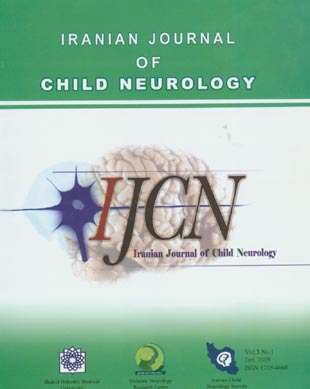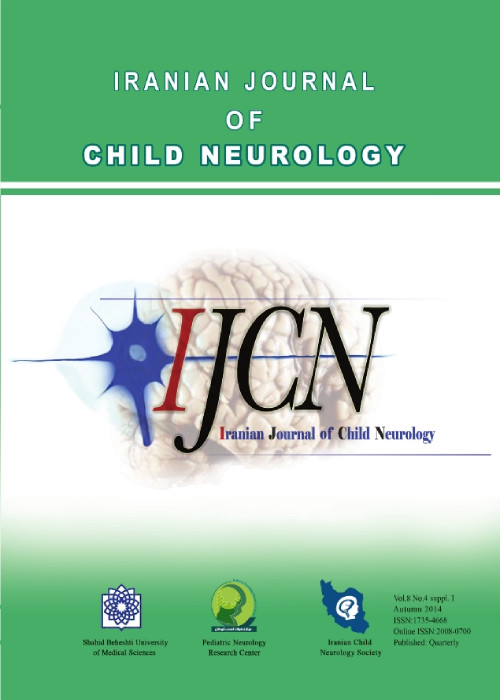فهرست مطالب

Iranian Journal of Child Neurology (IJCN)
Volume:3 Issue: 1, Winter 2009
- تاریخ انتشار: 1387/12/25
- تعداد عناوین: 10
-
-
Page 7The Guillain-Barre syndrome (GBS) is characterized by the acute onset of rapidlyprogressive, symmetric muscle weakness with absent or decreased deep tendon reflexes. GBS is the most common cause of acute flaccid paralysis in childhood, with an incidence of 0.6-4 per 100 000 population per year. The clinical features are distinct and obtaining patient''s history and conducting an examination generally lead to the diagnosis that can be confirmed by supportive laboratory tests and electrodiagnostic studies. The major considerations in differential diagnosis include transverse myelities, toxic neuropathy, tick paralysis, infantile butolism and myasthenia gravis. Although most children with GBS have a relatively benign clinical course, some become quite ill and require intubation with intensive care monitoring. Immunomodulating treatment should be used for any child who loses the ability to walk.
-
Page 15The ketogenic diet is a high-fat, low carbohydrate, adequate protein diet,developed in the 1920s for the management of intractable seizure disorders in children. To evaluate efficacy and tolerability of the classic ketogenic diet, we analyzed records of the children started on the diet from 1999 to 2006 at the Mofid children''s hospital.Materials & MethodsThe subjects were 87 children, mean age 55 months. Before initiation of the diet, 55% of the patients had seizures, at least 1-4 times per day, 36% - 5 or more per day and 9% - 2 to 4 times per week. Mean number of Anti Epileptic Drugs (AEDs) tried for them was 8 and 67% were receiving three or more drugs.ResultsThe ketogenic diet showed drastic improvement, with at least 50% reduction in seizure frequency in 87% of our patients, 39% of whom showed complete seizure control in the third month. After one year, in 80% of the patients who returned, improvement continued, with 26% of them being seizure free; besides, 23% had one AED decreased, 36% had two or three AEDs decreased, and 25% (one child) had all AEDs discontinued. Of the 30 improved cases, 20%, at the end of the first year, had improved behavior as well, and 23% of them had become more alert. The median diet duration of the improved group was 15 months.ConclusionThe improvement in our patients, low side effects, and the duration of diet by families reveal that the ketogenic diet can still be a very useful alternative therapy in certain epileptic children.
-
Page 21Midazolam is a significant and effective drug for control of a life-threatening condition, generalized and partial refractory convulsive status epilepticus. The goal of this study was evaluation of midazolam efficacy for management of this serious disease and its two side effects, hypotension and respiratory failure.Materials & MethodsOur study was done using a quasi experimental method; 22 children with generalized refractory convulsive status epilepticus and 13 with partial refractory convulsive status epilepticus were enrolled for the study. All patients received 0.2mg/kg/dose as a bolus intravenous midazolam followed by 1-6 mcg/kg/min continuous intravenous midazolam. Following this, termination of seizures as well as hypotension and respiratory failure were evaluated.ResultsMidazolam ceased stop convulsions in 81.81% (18) patients with generalized seizures, and in 76.92% (10) patients with partial seizures, showing no significant difference between these two types of seizures (p=0.52) Hypotension was induced in 18.18% (4) patients with generalized seizures and in 30.70% (4) patients with partial seizures, again difference not significant (p=0.14). There was respiratory failure in 21.73% (5) patients with generalized seizure and in 7.69% (1) patients with partial seizure, difference not significant.(p=0.09)ConclusionThere was no significant difference in efficacy and creation of hypotension and respiratory failure after continuous intravenous infusion of midazolam between generalized and partial refractory convulsive status epilepticus.
-
Page 27This study was performed to evaluate the normative data and psychometric properties and the internal consistency of the Farsi (Persian) version of the Strength and Difficulties Questionnaire (SDQ) self-report form, as a screening tool in a community-based sample of 12 to 17 year-old adolescents of urban Tehran.Materials and MethodsIn this investigation, 1105 adolescents (12 to 17 years old), selected from 250 clusters from all the 22 municipality areas of Tehran, responded to 25 questions of the Farsi version of SDQ self-report form. The frequency of each symptom domains according to Goodman''s cutoff points and 90th percentile and the mean score in each subscale were determined.ResultsThe 90th percentile cutoff points were somewhat different from those of the previous reports. Using Goodman''s cutoff points, the prevalence of symptom domains was relatively high. For example, 13.7 percent of the adolescents studied had total scores equal to 20 or more. There were significant correlations between different subscales and their constituting questions.ConclusionSelf-report form of SDQ is a valuable tool in the screening of adolescent psychopathologies. Frequency of majority of the symptom domains seems to be higher in the adolescents in Tehran urban areas.
-
Page 35Wilson disease (WD) is an inherited copper metabolism dysfunction disease characterized by cirrhosis and CNS findings. Wilson disease is important because it is fatal if not recognized and treated. Our Goal of study is to investigate the clinical signs and symptoms, lab results and other relevant matters in our patients in order to obtain a better understanding of this potentially lethal disease in our country.Materials & MethodsWe have evaluated 21 cases of children with Wilson disease who were referred to Loghman and Imam Hussein Hospital between years 1998-2005. The mean age of our patients was 9 years.ResultsThe presenting symptom was ascites and extremity edema in 6(28.5%) patients, behavioral changes or neurological signs in 5 (24%) simultaneous Ascites and icter in 9(43%) patients and in one patient the presenting manifestation was hemolytic anemia(4.8%). One of our patients died because of fulminant hepatitis in the course of admission(4.8%).Conclusionwe showed in this study that Wilson disease can be presented by a manifold symptoms in children and adolescence. Having a good concept of these symptoms and high clinical suspicious are required to diagnose this potentially lethal disease at the proper time in order to decrease the potential adverse effects of the disease especially the neuropsychiatric damages significantly.
-
Page 43The primary problem in children with cerebral palsy (CP), frequently referred for occupational therapy, is gross motor dysfunction. The current study was designed to investigate the effects of sensory integration therapy (SIT) on gross motor skills in CP patients.Materials & MethodsTwenty-four children with diplegic spastic CP were randomly divided into two groups: First group (n=14,6 girls, 8 boys), age range 2 to 6 years, mean age 3.9 years; the second or control group (n=10, 5 girls, 5 boys), age range 2 to 6 years, mean age 3.4 years. SIT training was given to the first group and only the home program was given for the second group. All children were evaluated with gross motor function measurement (GMFM 88) for rolling, sitting, crawling, standing and walking position before and after intervention. Treatment duration for both groups was 1 hour, 5 days per week for a period of 12 weeks.ResultsGross motor function in children of the case group improved significantly better that in the control group, after intervention in sitting (P=0.02), crawling (P=0.001) and standing (P=0.03) positions; however no significant difference was seen in rolling (P=0.65) and walking (P=0.69) ability assessment.ConclusionThis study showed the beneficial effects of the SIT training program for children with CP; the SIT intervention had a significantly positive effect on gross motor function in the children with diplegic spastic CP. Moreover the results of the present study showed that sensory integration and vestibular stimulation were effective in children with cerebral palsy.
-
Page 49Major differences exist in the anatomy and biomechanics of the growing spine that causes failure patterns different from those in adults. Spinal injury in the pediatric patient is a main concern because timely diagnosis and appropriate treatment can prevent further neurologic damage and deformity and potentiate recovery. We conducted a retrospective clinical study of 137 cases (93 boys, 44 girls) of pediatric cervical spine injuries, managed over fifteen years, to present data from a large series of pediatric patients with cervical spine injuries from a single regional trauma center. The aim was to assess and analyze complications, etiology, pathogenesis, site of injuries and age difference of cervical spine and spinal cord injury in a pediatric age group and compare the findings with current literature.Materials & MethodsOne hundred and thirty seven children with cervical spine injuries, seen over twelve years, were divided into two age groups: 54 patients were in group one (0-9 years) and 83 patients were in group two (10 - 17 years). We managed them according to status at presentation and type of injury. Forty seven patients were managed surgically and ninety nonsurgically (52 wore a halo brace and 38 wore different hard collars and braces). T-test and Chi squares were used to analyze differences between groupsResultsThe most common cause of injury was motor vehicle accidents(MVA). Our younger patients (Group 1) had sustained more neurological injuries than the older ones (Group 2), 77% vs.48%.; upper cervical spine was the most common site involved in 76%, while 43% suffered head injuries. In group two, 88% of children two sustained fractures or fracture/ subluxations; also in this group, subluxation, and fracture/ subluxation was present in 10 and 25% of children respectively. The most common radiological findings were vertebral fractures (38%). Solid fusions were demonstrated in all patients at late follow-up review (mean 6 years). None of the children developed neurological deterioration; however 18% mortality was documented. Various fusion techniques were used and neurological and fusion outcomes improved as compared with the previous reports.ConclusionOutcomes of cervical spine injuries in children are more positive than in adults, particularly in patients with incomplete injuries. The prognosis for children with complete spinal cord injuries, however, is still discouraging. Upper cervical spine injuries are more common between birth and 9 years of age; however fractures and fracture/subluxation are rare in this group. Surgical intervention with appropriate instrumentation and fusion are very effective in children with cervical spineinstability.
-
Page 57Moyamoya disease (MMD) is a chronic, occlusive, cerebrovascular disorder of unknown pathogenesis, characterized by progressive stenosis of the bilateral supraclinoid internal carotid arteries, with concomitant formation of tortuous arterial collateral vessels at the base of the brain, which reconstitute distal branches of the cerebral circulation. In Japanese, "Moyamoya" means "hazy puff of smoke" and refers to the angiographic appearance of the abnormal network of vessels that develop at the base of the brain and basal ganglia to supply a collateral route of blood flow. We report here the case of Moyamoya disease in a 5 year-old girl with normal mentality with a one year history of epilepsy, with Todd''s paralysis. This condition is rare and most patients are diagnosed in childhood. With this report we aim to underscore the possibility that a usual neurological sign could be associated with unusual neurological disorders.
-
Page 61Systemic lupus erythematosus (SLE), an autoimmune systemic disease with unknown etiology, affects virtually every part of the body; involvement of the central nervous system (CNS) is one of the major causes of morbidity and mortality in systemic lupus erythematosus (SLE) patients and is the least understood aspect of the disease. neutropenia is very uncommon in childhood lupus. True negative anti nuclear antibody (ANA) tests in patients with lupus are now very rare. The patient reported here was a 12-year-old girl with ANA negative lupus cerebritis who presented with left hemiparesia after a generalized seizure, with neutropenia observed during its course.


